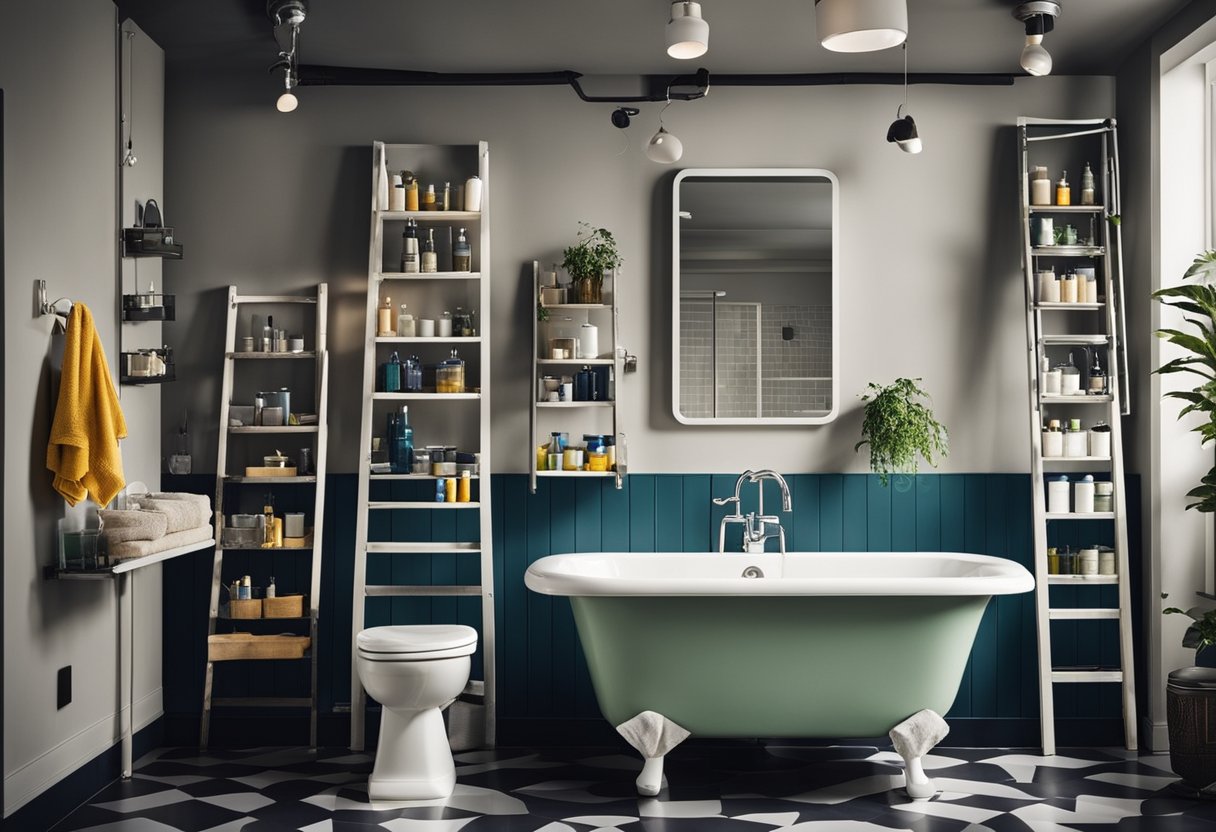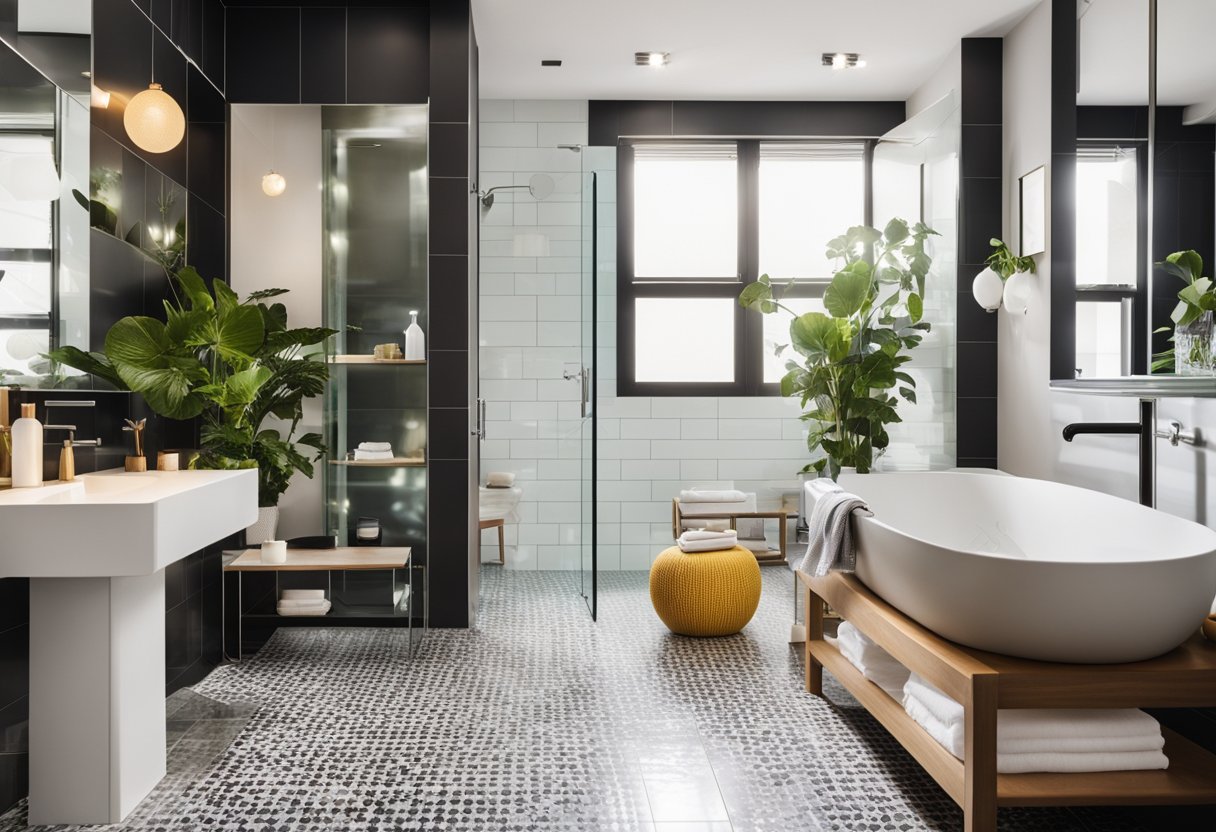Acrylic paintings are a popular choice for home decor, and many people wonder if they can be hung in a bathroom. Bathrooms can be a challenging environment for artwork due to high humidity and moisture levels, but with the right preparation and care, acrylic paintings can be a beautiful addition to any bathroom.
The key to hanging acrylic paintings in a bathroom is to protect them from moisture. Acrylic paintings are water-resistant, but they can still be damaged by prolonged exposure to humidity. To prevent warping or damage, it is important to frame acrylic paintings under glass with backing. This will protect the painting from moisture while still allowing it to be displayed.
If you want to add some color and personality to your bathroom, acrylic paintings are a great choice. With proper preparation and care, they can be a beautiful and durable addition to your bathroom decor. In the next section, we will explore the benefits of using acrylic paintings in your bathroom and how to prepare and display them properly.
Key Takeaways
- Acrylic paintings can be hung in a bathroom with the right preparation and care.
- Framing acrylic paintings under glass with backing is essential to protect them from moisture.
- Acrylic paintings are a beautiful and durable addition to any bathroom decor.
Understanding Acrylic Paintings
https://www.youtube.com/watch?v=R25NhqpK3fo&embed=true
As an artist, I have used various mediums to create art, including watercolor, oil, and acrylic. Acrylic paint is a popular choice for artists because it is versatile, easy to use, and dries quickly. It is also water-resistant and durable, making it an excellent choice for painting in the bathroom.
Acrylic paint is a synthetic polymer that was first developed in the 1940s. It is made up of pigment suspended in a water-based emulsion. The emulsion is made up of acrylic polymer particles that are suspended in water. When the paint is applied to a surface, the water evaporates, leaving behind a thin film of acrylic polymer that binds the pigment to the surface.
Acrylic paint is known for its bright, vibrant colors and its ability to be used on a variety of surfaces, including canvas, paper, wood, and even plastic. It is also easy to mix with other colors, allowing artists to create a wide range of shades and hues.
When it comes to acrylic paintings in the bathroom, it is important to take certain precautions to protect the artwork. Acrylic paintings can be hung in the bathroom, but they should be framed with backing and placed behind glass to protect them from moisture and humidity. This will help prevent the paint from warping or fading over time.
In conclusion, acrylic paintings are a popular choice for artists because of their versatility, bright colors, and durability. When it comes to hanging acrylic paintings in the bathroom, taking the necessary precautions to protect the artwork is crucial to ensure its longevity.
Why Choose Acrylic for Bathroom
https://www.youtube.com/watch?v=8NHobX30rmc&embed=true
As an artist who has experience with different types of painting materials, I highly recommend using acrylic paint for bathroom artwork. Here are a few reasons why:
Durability
Acrylic paint is known for its durability, which makes it an excellent choice for bathroom art. Bathrooms are often humid places, and acrylic paint is resistant to moisture. It won’t easily warp or damage, even when exposed to high levels of humidity. This means that your artwork will last longer and maintain its quality over time.
Water-Resistant
Acrylic paint is water-resistant, which is another reason why it’s an excellent choice for bathroom art. Bathrooms are often wet places, and artwork that is not water-resistant can quickly become damaged. Acrylic paint is less likely to be damaged by water than other types of paint, which means that your artwork will stay looking great for longer.
Versatility
Acrylic paint is incredibly versatile, which means that it can be used to create a wide variety of different styles and effects. Whether you want to create a bold and colorful piece or a more subtle and understated work of art, acrylic paint can help you achieve your vision.
Easy to Clean
Acrylic paint is easy to clean, which is another advantage when it comes to bathroom art. Bathrooms can be dirty places, and artwork that is not easy to clean can quickly become covered in dust and grime. Acrylic paint can be easily wiped down with a damp cloth, which means that your artwork will stay looking great with minimal effort.
Overall, acrylic paint is an excellent choice for bathroom art. It is durable, water-resistant, versatile, and easy to clean, making it the perfect medium for creating beautiful and long-lasting artwork for your bathroom.
Preparation and Application
https://www.youtube.com/watch?v=OIewwwXo-J0&embed=true
Before starting the actual painting process, it is important to prepare the bathroom surface properly. This will help ensure that the paint adheres well and lasts longer.
First, prepare the surface by cleaning it thoroughly. Use a mild detergent and water to remove any dirt, grime, or soap residue. Rinse the surface with clean water and let it dry completely.
Next, apply a layer of primer to the surface. This will help the paint adhere better and last longer. Choose a primer that is specifically designed for use in bathrooms. Apply the primer using a roller or paintbrush, and let it dry completely before proceeding with the painting process.
When it comes to painting, it is important to use the right tools. A roller is ideal for painting large surfaces, while a paintbrush is better suited for smaller areas and edges. Use a paint tray to hold the paint and a drop cloth to protect the floor and any fixtures in the bathroom.
Apply the first coat of paint using a roller or paintbrush, and let it dry completely before applying a second coat. Make sure to follow the manufacturer’s instructions regarding drying times between coats.
Overall, proper preparation and application are key to achieving a professional-looking paint job in your bathroom. By following these steps and using the right tools, you can ensure that your acrylic painting will last for years to come.
Choosing the Right Paint
https://www.youtube.com/watch?v=ZnvsIGrAa_o&embed=true
When it comes to painting a bathroom, choosing the right type of paint is crucial. The right paint can help protect your walls from moisture, mold, and mildew. Here are some factors to consider when choosing the right paint for your bathroom:
Water-Based vs. Oil-Based Paint
Water-based paint, also known as latex paint, is a popular choice for bathrooms. It dries quickly, has low odor, and is easy to clean up with soap and water. On the other hand, oil-based paint is more durable and has a smoother finish. However, it takes longer to dry, has a stronger odor, and requires solvents for clean-up.
Gloss vs. Satin vs. Eggshell Finish
The finish of the paint can also affect its durability and appearance. Glossy finishes, such as semi-gloss and high-gloss, are ideal for bathrooms because they are more resistant to moisture and can be easily wiped clean. Satin and eggshell finishes have a subtle sheen and are less reflective than glossy finishes. They are also more forgiving of imperfections on the wall.
Mold-Resistant Paint
Mold-resistant paint is specially formulated to prevent the growth of mold and mildew. It contains antimicrobial agents that inhibit the growth of bacteria and fungi. This type of paint is ideal for bathrooms with poor ventilation or high humidity.
Choosing the Right Color
When choosing the right paint color for your bathroom, it is important to consider the amount of natural light in the room. Dark colors can make a small bathroom feel even smaller, while light colors can make a bathroom feel more spacious. Neutral colors, such as beige and gray, are versatile and can complement a variety of bathroom styles.
In conclusion, choosing the right paint for your bathroom requires careful consideration of several factors, including the type of paint, finish, and color. Water-based paint with a glossy finish and mold-resistant properties is a good choice for most bathrooms. However, it is important to consult with a professional if you have any doubts or concerns.
Framing and Display
https://www.youtube.com/watch?v=Rkoi5aZHeT8&embed=true
When it comes to displaying acrylic paintings in the bathroom, framing is essential. A well-designed frame not only enhances the artwork but also protects it from moisture and steam. A wood frame is an excellent choice for acrylic paintings, as it adds a touch of elegance and sophistication to the artwork.
To further protect the painting, a backing should be used to keep moisture from seeping in from the back. This is especially important if the painting is in a bathroom or any other area that is exposed to moisture. A glass or plastic frame can be used to cover the painting, but it is not always necessary. If the painting is not in a high-traffic area, it can be left unframed.
When hanging the painting, it should be hung at eye level. This ensures that the painting is visible and can be appreciated. Additionally, the painting should be hung with a slight gap at the back to allow air to circulate and prevent moisture from building up.
Overall, framing an acrylic painting is an important step to ensure its longevity and beauty. A well-designed frame not only protects the painting but also enhances its design and beauty.
Safety and Maintenance
As an acrylic painting enthusiast, I know that hanging a painting in a bathroom can be a great way to add a pop of color and personality to the space. However, it is important to take certain safety and maintenance measures to ensure that the painting remains in good condition and does not pose any risks to your health.
Firstly, it is important to clean the bathroom regularly to prevent the buildup of dust, mildew, and mold growth. This includes cleaning the walls, door, toilet, ceiling, and windows. When cleaning the bathroom walls, it is important to avoid scrubbing too hard as this can damage the painting’s finish. Instead, use a gentle cleaning solution and a soft cloth to wipe away any dirt or grime.
Secondly, it is important to ensure proper ventilation in the bathroom to prevent the buildup of moisture and humidity. This can be achieved by opening windows or using a fan. Temperature shifts can also affect the painting, so it is important to maintain a stable temperature in the bathroom.
Thirdly, it is important to take safety measures when hanging the painting. If you are framing the painting under glass, make sure it is 100% sealed to prevent any VOCs or toxic chemicals from being released into the air. If you are using varnish on the painting, make sure to use a non-toxic, low VOC option.
Overall, with proper care and maintenance, an acrylic painting can be hung in a bathroom without any issues. Just make sure to clean the bathroom regularly, ensure proper ventilation, and take safety measures when hanging the painting.
Updating and Refreshing Bathroom Decor
As an acrylic painting enthusiast, I know firsthand how a simple piece of art can transform a room. Bathrooms are no exception. Updating and refreshing your bathroom decor can make a huge difference in the overall look and feel of the space.
One of the easiest and most inexpensive ways to update your bathroom is by switching out small decor pieces. High-quality, mildew-resistant shower curtains, bath mats, and towels can instantly refresh the room. If you’re looking to add some color or pattern, consider a new set of soap dispensers, toothbrush holders, or a decorative vase.
Another way to update your bathroom decor is by adding some art. Acrylic paintings are a great choice for bathrooms because they are moisture-resistant and easy to clean. You can find affordable pieces online or even create your own. Just be sure to hang them away from the shower or bathtub to avoid water damage.
If you’re looking to make a bigger impact, consider updating your bathroom fixtures. Swapping out old faucets, showerheads, and towel bars for new, modern ones can make a huge difference. You can also update your vanity with a fresh coat of paint or new hardware.
Finally, if you’re looking to protect your existing bathroom decor while making updates, consider using plastic sheeting or glass covering. These materials can be used to protect floors, walls, and countertops while you work on your bathroom project.
Overall, updating and refreshing your bathroom decor doesn’t have to be a daunting task. With a few simple updates and some creativity, you can transform your bathroom into a beautiful and functional space.
Frequently Asked Questions
Can you hang artwork in a bathroom?
Yes, you can hang artwork in a bathroom. However, you need to be careful about the type of artwork you choose and how you hang it. Acrylic paintings are a good option as they are durable and resistant to moisture.
How can you protect paintings in a bathroom from moisture?
To protect paintings in a bathroom from moisture, you can use a sealant or varnish to create a barrier between the painting and the moisture. You can also use a dehumidifier to reduce the humidity levels in the bathroom.
What are some art in bathroom ideas?
Some art in bathroom ideas include using abstract art, nature-inspired art, or black and white photography. You can also use a series of small paintings or a large statement piece.
Is it safe to hang pictures in a bathroom?
Yes, it is safe to hang pictures in a bathroom as long as you take the necessary precautions. You should use appropriate hardware and make sure the artwork is securely fastened to the wall.
How can you prevent moisture damage to bathroom artwork?
To prevent moisture damage to bathroom artwork, you should avoid hanging artwork in areas that are directly exposed to water. You can also use a dehumidifier to reduce the humidity levels in the bathroom.
What are some creative ways to display art in a bathroom?
Some creative ways to display art in a bathroom include using floating shelves, picture ledges, or a gallery wall. You can also use a decorative ladder or a vintage window frame to display your artwork.

Hi, I’m Sal Muller of Tooltrip.com. My DIY experience led me to understand essential power tools for home projects. Tooltrip.com guides enthusiasts and professionals in choosing right tools for any job. I provide concise top tool reviews for easier, efficient DIY.





